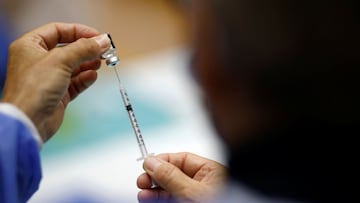What percentage of vaccination is needed for herd immunity?
Herd immunity once the mantra to end the pandemic, it is now acknowledged may be an elusive goal to reach but there is hope as youths get vaccinated.

In the early days of the Biden administration the vaccination rollout gained steam quickly to reach a brief period with over 4 million doses being administered daily. As the vaccination rate slips President Biden has set a new goal to get at least 70 percent of the population vaccinated with a single dose before 4 July.
There is hope that children, one of the key groups needed to help reach herd immunity, will soon be able to get their shots. Emergency use approval is expected this week from the FDA for the Pfizer vaccine in adolescents 12 to 15 years old.
Also see:
- US supports waiving coronavirus vaccine patents
- Moderna and Johnson & Johnson are still in clinical trials for children
- Will the nation's children be vaccinated before school begins in the fall?
- FDA expected to authorize Pfizer covid-19 vaccine for 12 to 15 age group
What percentage of the population needs to be vaccinated to reach herd immunity?
With each disease the proportion of people that must be vaccinated to provide protection to the unvaccinated varies. Experts' best guesses for covid-19, including Dr. Anthony Fauci, estimate the range is somewhere between 70 and 85 percent given that this is a new virus and is still being studied. For comparison, about 95 percent of the population needs to be vaccinated against measles while polio requires around 80 percent according to the WHO.
But given the complications of the covid-19 virus and the pandemic, attaining those levels of inoculation may be difficult. Dr. Fauci has acknowledged that experts have changed their thinking due to the confusion around the concept and what numbers would be needed to “reach this mystical level.” He says that now “we stopped using herd immunity in the classic sense,” adding “I’m saying: Forget that for a second. You vaccinate enough people, the infections are going to go down.”
Herd immunity occurs when a large portion of a community becomes immune to a disease, making the spread of disease from person to person unlikely. As a result, the whole community becomes protected—not just those who are immune. https://t.co/uNBlEoZdAK #OurShot2SaveLives pic.twitter.com/xOsyctqwMu
— Mayo Clinic (@MayoClinic) May 5, 2021
Reaching herd immunity will be difficult but there is hope
Lauren Ancel Meyers, who manages the Covid-19 Modeling Consortium at the University of Texas, listed off the reasons to CNN why getting to herd immunity will be so difficult. Due to the scope of the contagion and the lack of vaccines to inoculate the world population there will be reservoirs of the disease. In those areas, if the virus is free to run amuck without control mutations will develop which in turn could lessen the efficacy of the vaccines.
Related stories
Even in the US which is now awash in vaccine doses these pockets can exist in the population that refuses to get vaccinated. Currently, about a quarter of the population is hesitant or unwilling to get vaccinated. And relying on getting infected and riding it out to get immunization isn’t a guarantee. As with the vaccine, the length of time after the primary infection that a person will have immunity against reinfection is not fully known. Researchers are studying booster shots for the covid-19 vaccines.
New CDC report: Coronavirus infections could be under control this summer in the U.S. if the vast majority of people get vaccinated and continue with precautions against viral transmission. https://t.co/JzrWViwY4O
— Kyle Griffin (@kylegriffin1) May 6, 2021
On the bright side though approval for the Pfizer vaccine in adolescents is expected this week and the company plans to ask for authorization for kids 2 to 11 in September. The other two vaccines that have received approval in adults are doing clinical trials for younger cohorts. Children represent about 23 percent of the population, and although they have less severe symptoms, they can still be a vector for transmission.
- OMS
- Anthony Fauci
- Joseph Biden
- Science
- Coronavirus Covid-19
- Vaccines
- United States
- Pandemic
- Coronavirus
- ONU
- Vaccination
- Infectious diseases
- Virology
- Outbreak
- North America
- Crimes against public health
- Preventive medicine
- Diseases
- Microbiology
- Health policy
- International organisations
- Medicine
- America
- Health service
- Foreign relations
- Life sciences
- Biology


